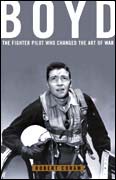 Boyd:
The Fighter Pilot Who Changed the Art of War.
By Robert Coram
Boyd:
The Fighter Pilot Who Changed the Art of War.
By Robert Coram

 Boyd:
The Fighter Pilot Who Changed the Art of War.
By Robert Coram
Boyd:
The Fighter Pilot Who Changed the Art of War.
By Robert Coram
Robert Coram's book illuminates the personality of one of the most insightful military tacticians in history, John Boyd. It follows his relentless pursuit to improve his theories of aerial combat and military tactics. He was strongly motivated by his anticipation of the breakthroughs in combat theory that he believed he would eventually make. Coram describes Boyd's influence on fighter development and military tactics through the development of relationships with six "acolytes". Coram devotes entire chapters to the accomplishments and tribulations of Boyd's acolytes as they attempted to promote the adoption of his concepts throughout the military establishment.
Boyd's innate ability to counter the tactics of other fighter pilots was legendary. While serving as an instructor at the Air Force Fighter Weapons School, he had a standing bet that any pilot could put his fighter behind Boyd's airplane, and Boyd would maneuver to a position behind the other pilot in less than 40 seconds or pay him $40. No pilot ever won that bet.
Although Boyd is perhaps most famous for never being defeated in aerial combat, his most significant contribution to aerial combat strategy was the development of Energy-Maneuverability Theory, which made it possible to analyze air to air combat mathematically. His E-M tables made it possible to compare the performance of different types of fighter planes at all altitudes and airspeeds, illuminating those areas where a fighter pilot's airplane would be able to outperform an opponent's airplane, and also those areas where his airplane would prove inferior. Through the application of Energy-Maneuverability Theory, Boyd was able to author his Aerial Attack Study, which fundamentally changed the way that fighter pilots thought about air-to-air combat.
Boyd was a strong adherent to the lightweight fighter concept. His intimate understanding of E-M tables instilled in him a fervent belief that increased weight was the greatest enemy of fighter airplane performance. He influenced the development of the McDonnell-Douglas F-15 Eagle, and the General Dynamics F-16 Fighting Falcon, although both evolved away from his concept of the optimal lightweight fighter as they were developed to take on more roles. He and his acolytes became known in the Pentagon as the "Fighter Mafia".
Robert Coram's book sheds light on the uphill battle facing those who would introduce new modes of thought to firmly entrenched bureaucracy. It describes the personal and professional sacrifices that John Boyd made in his relentless pursuit to change patterns of thought.
Former U.S. Navy Commander Dick Allen wrote me to say the following about Boyd:
As an old F4U-4 and F8F-2 fighter pilot I thoroughly enjoyed the book. Though somewhat flawed as a husband and father his contributions to fighter tactics are unrivalled. His fights with the generals for promotion and recognition were classic and illustrate the difficulty for original thinkers when they come up against the closed minds so prevalent in the Pentagon. I believe Rumsfeld is shaking that system up however. The review was right on and the book is a must read for anyone interested in air warfare. What a talent!!!
This book is available from Amazon.com.
Send a message to Brian.